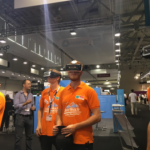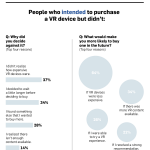Virtual reality standards: Too early or long overdue?
Virtual reality standards: Too early or long overdue?

Imagine that you bought a new printer for the office. You connect it to your PC, install its demonstration software and make sure that it works well. Then, an unfortunate surprise: your word processor absolutely will not work with this printer. You’ll need to wait until the maker of the word processor releases a new version. When will this version be available? Should you return the printer? Should you change to a different word processor?
While this may seem like a scenario from the 1980’s, when it comes to virtual reality (VR) it’s exactly where we are today. Industry analysts and the media have been speculating whether the VR industry will ever take off. As Financial Times recently put it, “the VR market so far has not played out as anyone quite anticipated.” One of the largest problems is that VR experiences are often hard-coded to one set of hardware devices . Only a specific VR device, coupled with its tracking system and
Only a specific VR device, coupled with its tracking system and controller will work with a specific PC. If you want to use one VR experience with a different VR hardware, it’s likely that you will be out of luck. This issue is often called “API fragmentation,” or the lack of consistency in way that VR software interacts with VR hardware. For emerging markets like VR, it can significantly hold back consumer adoption.
Is this a problem that the industry should try and solve? Some claim that because VR is new, these issues are inevitable and will eventually work themselves out. Others seem to resist “solving” this issue to remain competitive. A vendor relying on a “walled-garden” approach (i.e. controlling and limiting user options), often leverages this very problem to dominate an entire market. Giving consumers the ability to swap out VR hardware or use a different app store might not be what they have in mind.
Standards needed to overcome API fragmentation
Fortunately, many understand that the success of the VR industry relies on solving this problem quickly. Standards for the VR industry need to be put into place to overcome the API fragmentation that is holding it back.
This approach has worked in many other technology markets. For example, if you have a Dell computer, you can choose to use a non-Dell printer with it. The same goes for keyboards, mice, scanners and so forth. These are mostly all interoperable with various devices in today’s market. A VR system might have just as many peripheral devices: headsets (HMDs), trackers, controllers and more. A new, universal standard way for a program to interface with these VR devices is the key to enabling the market to thrive for years to come.
Almost everyone would benefit from a standard. If VR software could work across different hardware combinations, consumers could mix and match devices to their liking and price point. They could also be confident that their VR investments are future-proof. A 2017 game would likely work with 2018 or 2019 hardware.
Additionally, game publishers and other experience creators would have a larger addressable market. Today, developers hard-code their game to a particular set of hardware devices but tomorrow, they could create programs for any device that has a conforming “driver.” Last, manufacturers that support a standard would have their devices work with lots of content. This would allow even small players to enter the market because their customers would have immediate access to content. In all, standards promote innovation instead of spending energy on chasing ever-evolving device APIs.
The benefits for all parties in the ecosystem speak for themselves. What would these standards look like? And, how will they be implemented?
Standardization will turbocharge innovation
In VR and AR, the elements that need to be standardized are the device interface and the application interface. Device interface standards would define how to configure VR devices of particular type and how to extract data from them. To draw a parallel, printers have different capabilities but share the same basic functions. The same is true for VR devices. Applications interface standards would describe how a VR application or a game engine renders its content and receives data. If these two core elements are standardized across all VR hardware and software offerings, industry adoption and innovation would skyrocket.
Fortunately, some organizations have already embarked on a mission to begin this shift to VR industry standardization. For example, Open-Source Virtual Reality (OSVR) implements both a device interface layer as well as an application layer to support hundreds of devices, and most of the OSVR code is free and open-source. Additionally, OpenVR, an open API (though not open source) from Valve, allows all VR devices to work with SteamVR content. This January, the Khronos group launched a new VR initiative called OpenXR, which brings together a wide range of companies to combine lessons learned from building OSVR,
This January, the Khronos group launched a new VR initiative called OpenXR, which brings together a wide range of companies to combine lessons learned from building OSVR, OpenVR and proprietary APIs. Industry leaders including Google, Intel, Oculus, Valve, Samsung and Sensics have all joined the initiative, which aims to create both a device interface as well as application interface to set a new standard.
The momentum is building, but we still have ways to go. Without standards, the VR industry may falter. They are a crucial element for adoption, will make the VR consumer experience far better and will promote critical innovation.
The post Virtual reality standards: Too early or long overdue? appeared first on ReadWrite.
(52)














